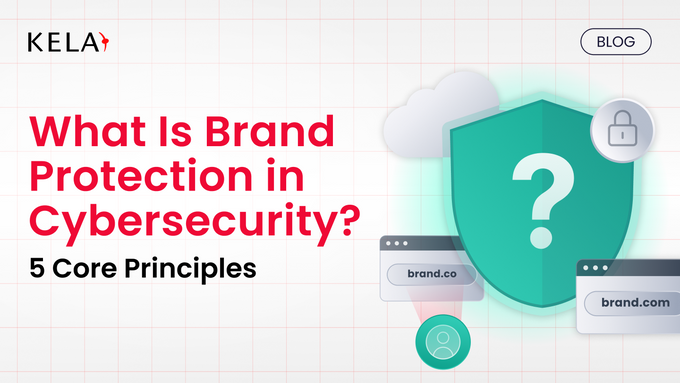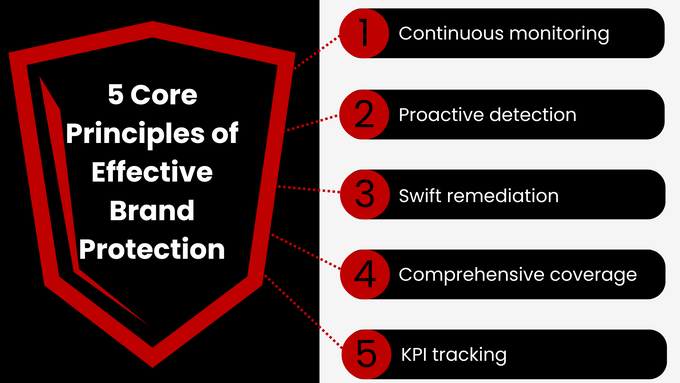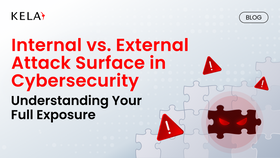What Is Brand Protection in Cybersecurity? 5 Core Principles
The core principles of brand protection in cybersecurity include continuous monitoring, proactive detection, swift remediation, comprehensive coverage, and KPI tracking. Together, these principles help protect brands from rapidly-evolving cyber threats to brand integrity.
Published June 30, 2025

In the digital age, your brand's reputation is as vulnerable to cyber threats as your data. Inadequate brand protection can expose your organization to a cascade of risks, from phishing attacks that mimic your identity to counterfeit products that erode customer trust. When cybercriminals exploit your brand, they don't just steal data; they steal credibility, leading to significant financial losses, damaged reputation, and eroded customer loyalty.
In a landscape where trust is paramount, proactive brand protection in cybersecurity is no longer an option—it's a necessity. This blog post will explore the core principles that can help you safeguard your brand from the ever-evolving threats lurking in the digital shadows.
» Looking for a brand protection solution? Look no further than KELA
What Is Brand Protection in Cybersecurity?
Brand protection in cybersecurity is understood as the implementation of proactive strategies and measures aimed at safeguarding your brand's identity, reputation, and intellectual property from online threats.
It is characterized by the monitoring, detection, and mitigation of brand abuse, impersonation, and other malicious activities across digital channels.
Benefits of Brand Protection
- Financial loss prevention: Brand impersonation attacks, such as phishing or counterfeit sales, can result in direct financial losses for businesses and their customers. By engaging in brand protection, these losses can be minimized.
- Customer trust maintenance: Cybercriminals often exploit brand reputation to deceive customers with counterfeit products. Brand protection is essential to ensure that customers can trust the authenticity of online interactions and transactions with your brand.
- Reputational integrity protection: Online brand abuse can swiftly damage your reputation through misinformation, fraudulent activities, or association with negative content. Brand protection is vital for preserving brand value and public perception.
- Intellectual property safeguarding: Brand protection is beneficial for detecting and preventing the unauthorized use of trademarks, logos, and other intellectual property, thereby protecting a company's valuable assets.
- Legal risk mitigation: Brand protection efforts can assist businesses in complying with regulations and avoiding legal issues related to trademark infringement, counterfeiting, and consumer protection.
» Don't get confused: The differences between vulnerability vs. threat vs. risk
Real-World Examples of Brand Protection Successes
- Netflix and phishing prevention: Netflix has taken a proactive approach to combat phishing scams that target its users. By employing advanced AI tools to detect and shut down phishing domains and conducting public awareness campaigns, Netflix has effectively minimized phishing incidents while protecting its brand reputation and customer trust in the digital space.
- Burberry and social media impersonation: Luxury brand Burberry has used AI-powered tools to scan social media platforms for fake accounts selling counterfeit products. By proactively identifying and reporting these accounts and collaborating with platforms for takedowns, Burberry has protected its brand's online presence and maintained the value of its genuine products in the digital marketplace.
Primary Cybersecurity Threats to Brand Reputation
- Phishing: Deceptive attempts are made to obtain sensitive information by impersonating a trustworthy entity, often resulting in data breaches and financial losses that harm brand trust.
- Brand impersonation: Fake websites, social media accounts, or emails are created that mimic a legitimate brand to deceive customers, distribute malware, or conduct fraud.
- Counterfeiting: Fake products are sold online that use a brand's trademarks or logos, leading to financial losses, reputational damage, and a decline in customer trust regarding product authenticity.
- Data breaches: Unauthorized access to sensitive data by infostealers, such as customer information or intellectual property, is experienced, resulting in financial losses, legal liabilities, and significant reputational damage.
- Domain spoofing: Domain names that closely resemble a legitimate brand's domain are created to deceive users into visiting malicious websites or responding to phishing emails.
» Here's how to prevent phishing attacks
The Future of AI-Powered Cyber Threats
The rapid advancement of artificial intelligence (AI) is introducing new and complex challenges to the protection of online presence, the security of digital assets, and the safety of content.
Anticipated threats, concerns, and considerations include:
- AI-powered impersonation: AI-generated deepfakes and highly realistic synthetic media can be utilized to create convincing impersonations of individuals or brands, which can lead to the spread of misinformation, damage to reputations, and facilitation of fraud.
- Automated cyberattacks: Cyberattacks can be automated and accelerated by AI, resulting in more sophisticated and challenging threats to defend against. This includes AI-driven phishing campaigns, malware development, and exploitation of vulnerabilities.
- Content manipulation and misinformation: The manipulation or generation of fake content, including images, videos, and text, can be achieved through AI, leading to the spread of misinformation, manipulation of public opinion, and erosion of brand trust.
- Data poisoning and AI model attacks: Data used to train AI models can be manipulated by attackers, resulting in biased or inaccurate outcomes. Attacks can also be launched on AI models to extract sensitive information or cause malfunctions.
- Evasion of AI-driven defenses: Techniques powered by AI are being developed by attackers to evade detection by AI-based security systems, necessitating continuous adaptation and enhancement of defensive measures.
Remember: The use of AI in security and content moderation is raising ethical concerns regarding bias, privacy, and freedom of speech. It is essential that these ethical implications are considered to promote the responsible development and deployment of AI tools.
» Learn more: How cybercriminals exploit generative AI
5 Core Principles of Effective Brand Protection
1. Continuous Monitoring
Continuous monitoring strengthens your brand's security by providing real-time visibility into online activities that may threaten it. It involves automated scanning of websites, social media, marketplaces, and the dark web to detect the following threats as they emerge:
- Phishing sites
- Impersonating accounts
- Counterfeit listings
- Data leaks as they emerge
Best Practices
- Use AI-powered tools: Leverage artificial intelligence and machine learning to automate threat detection and pattern recognition, enabling faster and more accurate identification of suspicious activities that human analysts might miss.
- Integrate threat intelligence feeds: Incorporate real-time threat intelligence from diverse sources (dark web monitoring, vulnerability databases, industry feeds, etc.) to provide context and early warnings about emerging threats targeting your brand or assets.
- Regularly review monitoring parameters to adapt to new threats: Continuously update and refine monitoring rules, thresholds, and detection patterns to reflect the evolving threat landscape, ensuring that your monitoring system remains effective against new and sophisticated attacks.
Overcoming Continuous Monitoring Challenges
Data overload and the need for accurate threat identification are the main challenges with this principle. They can be overcome with the following strategies:
- Prioritize alerts based on rise
- Use machine learning to filter out noise
- Employ expert analysts to validate potential threats
2. Proactive Detection
Proactive detection goes beyond reacting to known threats—it involves anticipating and identifying emerging threats before they cause harm. This includes using threat intelligence to understand attacker tactics and identifying early warning signs of phishing campaigns, impersonation attempts, counterfeit operations, and potential data leaks.
Best Practices
- Stay updated on the latest threat trends: Continuously research and track emerging cyber threats, vulnerabilities, and attack techniques to understand the evolving landscape and anticipate potential risks to your brand.
- Adapt detection rules: Regularly modify and refine detection rules and signatures based on the latest threat intelligence and observed attack patterns, ensuring that your security systems can effectively identify new and sophisticated threats.
- Use AI to identify anomalous activity: Implement AI-powered analytics to detect deviations from normal behavior, identify unusual patterns, and surface potential indicators of compromise that may signal an impending attack.
Overcoming Proactive Detection Challenges
The risk of false positives is a primary challenge of proactive detection along with the difficulty of identifying novel attack methods in a rapidly-evolving space.
Strategies to overcome these include:
- Continuous refinement of detection algorithms
- Human validation of flagged potential threats
- Collaboration with threat intelligence analysts and communities
» Don't miss these reasons you need cyber threat intelligence
3. Swift Remediation
Quick action is crucial to reduce financial losses and reputational damage. Swift remediation minimizes the impact of cyber threats by taking rapid action to contain and neutralize them. This includes:
- Taking down phishing sites
- Removing impersonating accounts
- Delisting counterfeit listings
- Mitigating the damage from data leaks
Enforcing this might involve automated takedown procedures, collaboration with online platforms and marketplaces, and legal intervention.
Best Practices
- Have pre-defined response plans: Develop and document detailed incident response plans for various types of cyber threats and brand protection incidents, outlining clear roles, responsibilities, and procedures to ensure rapid and coordinated action.
- Establish strong relationships with relevant authorities: Cultivate relationships with law enforcement, regulatory bodies, and industry partners to facilitate information sharing, collaboration, and swift action in the event of a significant cyber incident or brand abuse.
- Adapt remediation strategies to the specific platform or threat: Tailor remediation efforts to the unique characteristics of the affected platform (social media, e-commerce, websites) or the specific type of threat (phishing, counterfeiting).
Overcoming Swift Remediation Challenges
Challenges include the difficulty of removing malicious content quickly and the potential for legal complexities. Strategies to overcome these include:
- Prioritizing takedown requests based on severity
- Leveraging legal expertise
- Working with specialized brand protection services that have established relationships with online platforms
4. Comprehensive Coverage
Comprehensive coverage utilizes continuous monitoring to ensure that all potential attack vectors and channels are protected, including websites, social media, marketplaces, mobile apps, the dark web, and other online platforms. It prevents attackers from exploiting blind spots and provides a holistic view of the brand's security posture.
Best Practices
- Regularly assess your brand's online presence: Conduct periodic audits of your brand's digital footprint across all relevant platforms (websites, social media, marketplaces, forums) to identify potential vulnerabilities, brand abuse, or unauthorized use of your intellectual property.
- Identify new channels or platforms: Stay vigilant for emerging online channels and platforms where your brand might be represented or exploited, and proactively extend your monitoring and protection strategies to cover these new areas.
Overcoming Comprehensive Coverage Challenges
Challenges include the vastness of the internet and the difficulty of monitoring all potential sources. To overcome them:
- Include prioritizing monitoring based on risk
- Use AI to identify relevant data
- Leverage specialized threat intelligence to focus on the most critical areas
5. KPI Tracking
The success of a cybersecurity-driven brand protection strategy should be measured by tracking relevant key performance indicators (KPIs) to identify which areas are improving and which need more focus. Some of these KPIs include:
- Number of phishing incidents: Observe the reduction in successful phishing attacks that leverage your brand's name or logo. This will directly reflect the effectiveness of brand protection efforts in preventing this common threat.
- Average time to detect (TTD) and respond (TTR): Identify how long it takes to address instances of brand impersonation, counterfeit listings, or other forms of abuse. This will indicate the speed and efficiency of your brand protection strategy.
- Reduction in counterfeit listings: Assess the decrease in online listings for counterfeit products that infringe on the brand's intellectual property. This KPI will demonstrate the impact of brand protection on combating counterfeiting.
- False positive rate: This tracks how many alerts are false. Lower is better and will show the quality of your monitoring tools.
- Website traffic and engagement: Tracks clicks, bounce rates, and user engagement to identify any disruptions or negative impacts caused by cyberattacks
» Stay up to date with these trends shaping the future of cybercrime and the future of cybercrime threat intelligence
Secure Your Brand Identity With KELA
In the relentless battle to safeguard brand integrity against the state of modern cybercrime, it's clear that traditional cybersecurity measures alone are no longer sufficient. The evolving landscape of cyber threats demands a more proactive and nuanced approach. To truly protect your brand, you must venture beyond surface-level monitoring and delve into the hidden corners of the digital underworld.
This is where solutions like KELA Cyber's Threat Actors Hub shine, offering actionable threat intelligence sourced directly from criminal forums and encrypted channels. By proactively detecting emerging threats, contextualizing intelligence for actionable insights, and providing targeted monitoring based on specific brand assets, KELA Cyber empowers businesses to stay one step ahead of cybercriminals.
» Ready to get started? Try KELA for free


